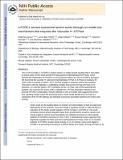| dc.contributor.author | Zoncu, Roberto | |
| dc.contributor.author | Bar-Peled, Liron | |
| dc.contributor.author | Efeyan, Alejo | |
| dc.contributor.author | Sancak, Yasemin | |
| dc.contributor.author | Sabatini, David M. | |
| dc.contributor.author | Wang, Shuyu, Ph. D. Massachusetts Institute of Technology | |
| dc.date.accessioned | 2015-04-24T18:27:40Z | |
| dc.date.available | 2015-04-24T18:27:40Z | |
| dc.date.issued | 2011-11 | |
| dc.date.submitted | 2011-04 | |
| dc.identifier.issn | 0036-8075 | |
| dc.identifier.issn | 1095-9203 | |
| dc.identifier.uri | http://hdl.handle.net/1721.1/96799 | |
| dc.description.abstract | The mTOR complex 1 (mTORC1) protein kinase is a master growth regulator that is stimulated by amino acids. Amino acids activate the Rag guanosine triphosphatases (GTPases), which promote the translocation of mTORC1 to the lysosomal surface, the site of mTORC1 activation. We found that the vacuolar H+–adenosine triphosphatase ATPase (v-ATPase) is necessary for amino acids to activate mTORC1. The v-ATPase engages in extensive amino acid–sensitive interactions with the Ragulator, a scaffolding complex that anchors the Rag GTPases to the lysosome. In a cell-free system, ATP hydrolysis by the v-ATPase was necessary for amino acids to regulate the v-ATPase-Ragulator interaction and promote mTORC1 translocation. Results obtained in vitro and in human cells suggest that amino acid signaling begins within the lysosomal lumen. These results identify the v-ATPase as a component of the mTOR pathway and delineate a lysosome-associated machinery for amino acid sensing. | en_US |
| dc.description.sponsorship | Damon Runyon Cancer Research Foundation | en_US |
| dc.description.sponsorship | Millennium Pharmaceuticals, Inc. | en_US |
| dc.description.sponsorship | American Lebanese Syrian Associated Charities | en_US |
| dc.description.sponsorship | Howard Hughes Medical Institute | en_US |
| dc.language.iso | en_US | |
| dc.publisher | American Association for the Advancement of Science (AAAS) | en_US |
| dc.relation.isversionof | http://dx.doi.org/10.1126/science.1207056 | en_US |
| dc.rights | Creative Commons Attribution-Noncommercial-Share Alike | en_US |
| dc.rights.uri | http://creativecommons.org/licenses/by-nc-sa/4.0/ | en_US |
| dc.source | PMC | en_US |
| dc.title | mTORC1 Senses Lysosomal Amino Acids Through an Inside-Out Mechanism That Requires the Vacuolar H+-ATPase | en_US |
| dc.type | Article | en_US |
| dc.identifier.citation | Zoncu, R., L. Bar-Peled, A. Efeyan, S. Wang, Y. Sancak, and D. M. Sabatini. “mTORC1 Senses Lysosomal Amino Acids Through an Inside-Out Mechanism That Requires the Vacuolar H+-ATPase.” Science 334, no. 6056 (November 3, 2011): 678–683. | en_US |
| dc.contributor.department | Massachusetts Institute of Technology. Department of Biology | en_US |
| dc.contributor.department | Whitehead Institute for Biomedical Research | en_US |
| dc.contributor.department | Koch Institute for Integrative Cancer Research at MIT | en_US |
| dc.contributor.mitauthor | Zoncu, Roberto | en_US |
| dc.contributor.mitauthor | Bar-Peled, Liron | en_US |
| dc.contributor.mitauthor | Efeyan, Alejo | en_US |
| dc.contributor.mitauthor | Wang, Shuyu | en_US |
| dc.contributor.mitauthor | Sancak, Yasemin | en_US |
| dc.contributor.mitauthor | Sabatini, David M. | en_US |
| dc.relation.journal | Science | en_US |
| dc.eprint.version | Author's final manuscript | en_US |
| dc.type.uri | http://purl.org/eprint/type/JournalArticle | en_US |
| eprint.status | http://purl.org/eprint/status/PeerReviewed | en_US |
| dspace.orderedauthors | Zoncu, R.; Bar-Peled, L.; Efeyan, A.; Wang, S.; Sancak, Y.; Sabatini, D. M. | en_US |
| dc.identifier.orcid | https://orcid.org/0000-0001-6366-7986 | |
| dc.identifier.orcid | https://orcid.org/0000-0002-1446-7256 | |
| dspace.mitauthor.error | true | |
| mit.license | OPEN_ACCESS_POLICY | en_US |
| mit.metadata.status | Complete | |
